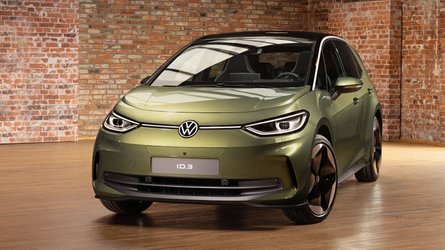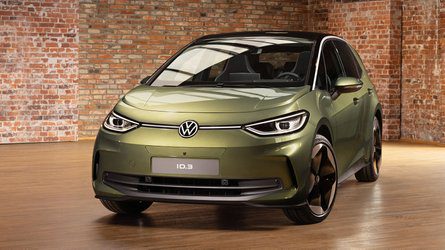Two and a half years after the launch of the Volkswagen ID.3, the automaker has unveiled the facelifted variant of the model that inaugurated its ID family of EVs. The 2024 ID.3 has received a comprehensive upgrade, including the latest software with new convenience and assist systems. On the outside, the most visible update is the more aggressive front bumper with enlarged air cooling openings, new light signatures for the LED headlights and taillight clusters, new aero-optimized alloy wheels, a black roof with matt-silver trim on the edges, and new colors including the Dark Olivine Green iridescent metallic paint. Inside, the haptic experience has been optimized thanks to improved material quality, including soft, foam-backed surfaces in the cockpit and remodeled door panels with softer and larger surfaces, and more generous hand rests. The interior is now completely animal-free, with a high proportion of recycled materials. The infotainment system features several changes in the menu structure, such as a clearer, more informative charging menu. The smart Electric Vehicle Route Planner has been updated and improved. The ID.3’s electronic architecture adopts a new concept, using two high-performance computers known as ICAS (In-Car Application Servers) as the main components. Updates in the area of assist systems include the use of swarm data in the Travel Assist feature, while Park Assist Plus with memory function allows automatic retrieval and use of saved parking maneuvers. The facelifted ID.3 continues with the same rear-mounted electric drive motor rated at 150 kilowatts (201 horsepower) and 310 Newton-meters (228 pound-feet) of torque. The 58-kWh and 77-kWh battery packs remain available with the same WLTP range ratings. At a DC fast-charging station, the 77-kWh battery of the ID.3 Pro S can charge from 5 to 80 percent within 30 minutes at a rate of up to 170 kW. The facelifted ID.3 will start shipping to customers in Europe in the fourth quarter of 2023.
Volkswagen has unveiled a facelifted version of its ID.3 electric vehicle, two and a half years after its initial launch. The car has received a comprehensive upgrade, including new convenience and assist systems, as well as subtle styling changes that give it a more striking look. On the outside, there is an aggressive front bumper with enlarged air cooling openings, new light signatures for the LED headlights and taillight clusters, new aero-optimized alloy wheels, a black roof with matt-silver trim on the edges, and new colors including Dark Olivine Green iridescent metallic paint. Inside, the haptic experience has been improved with soft, foam-backed surfaces in the cockpit and remodeled door panels with larger surfaces and more generous hand rests. The interior is now completely animal-free, with a high proportion of recycled materials. The infotainment system has been updated with a clearer charging menu and improved Electric Vehicle Route Planner. The ID.3’s electronic architecture adopts a new concept, using two high-performance computers known as ICAS (In-Car Application Servers) as the main components. Updates in the area of assist systems include the use of swarm data in the Travel Assist feature, while Park Assist Plus with memory function allows automatic retrieval and use of saved parking maneuvers. The facelifted ID.3 continues with the same rear-mounted electric drive motor rated at 150 kilowatts (201 horsepower) and 310 Newton-meters (228 pound-feet) of torque. The 58-kWh and 77-kWh battery packs remain available with the same WLTP range ratings. Customers in Europe will be able to purchase the facelifted ID.3 in the fourth quarter of 2023.
FAQ
Q1: Are electric car batteries recyclable?
A1: Yes, electric car batteries are recyclable.
Q2: Are electric car chargers free?
A2: It depends on the charger and the location. Some electric car chargers are free, while others may require a fee.
Q3: Can electric car batteries be rebuilt?
A3: Yes, electric car batteries can be rebuilt with the right tools and knowledge.









